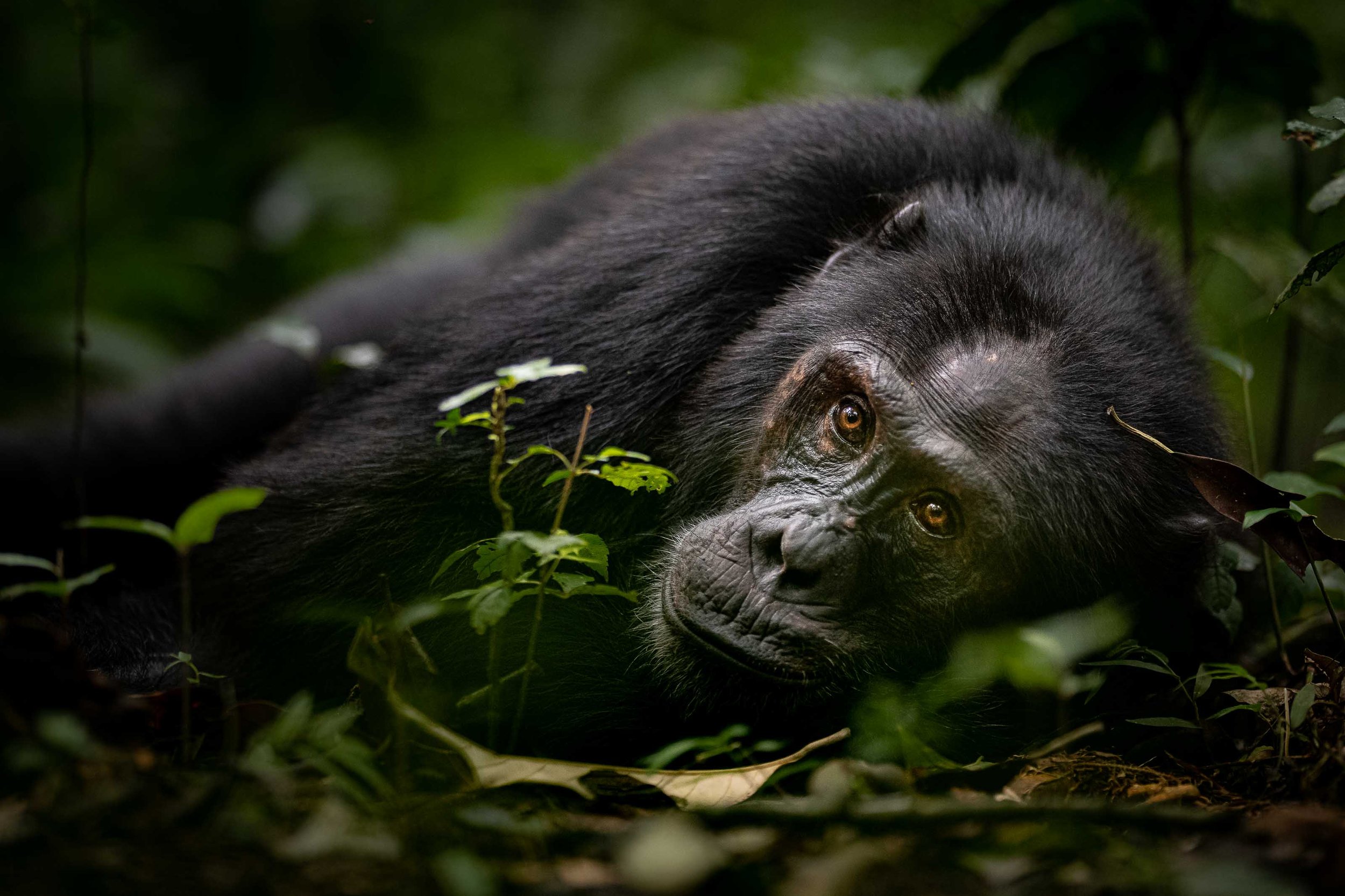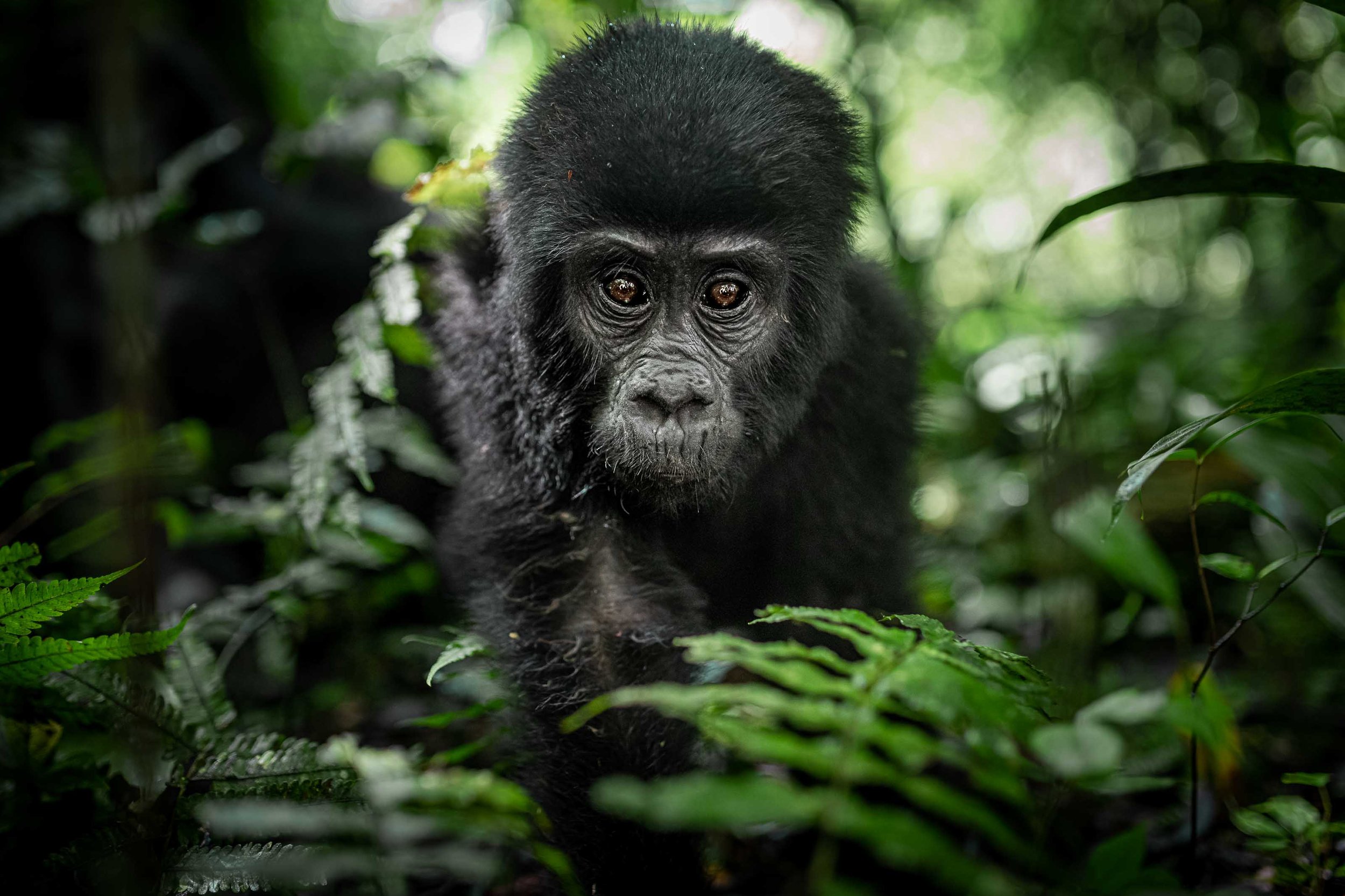Chimpanzee Photos: Tips For Stunning Primate Photography In Uganda
Chimpanzees are some of the most captivating subjects in wildlife photography. Their deeply expressive faces, social interactions, and intelligent behaviours make for compelling images.
But unlike photographing big cats in the open savannah, capturing chimps in dense forests presents unique challenges.
With low light, fast movements, and thick vegetation, you must adapt your approach when photographing chimps. You’ll need a high ISO, slower shutter speeds, and, most importantly, you’ll need to prioritise storytelling over technical perfection.
Sable: A memorable chimpanzee encounter
One of my most unforgettable chimpanzee encounters was with Sable, a chimp I photographed in Uganda’s Kibale Forest in 2018.
The conditions were far from ideal for photography. It was the end of a dark and rainy day, under the dense forest canopy. I had to use a high ISO and a slow shutter speed, which resulted in a soft image.
Yet, despite its imperfections, this photograph remains one of my favourites. Why? Because it captures the essence of Sable. The emotion in his expression is what draws people in.
"Most people won’t care if the picture is soft or grainy. What they care more about is who they are looking at." – David Lloyd
This philosophy underpins my approach to wildlife photography. The subject comes first, composition second, and technical settings last. A technically perfect image means little if it lacks emotion or storytelling.
Chimpanzees in Uganda: A wildlife photographer’s dream
Uganda is home to more primates than any other African country, including over 5,000 wild chimpanzees. As our closest living relatives, sharing 98.7% of our DNA, chimps exhibit behaviours strikingly similar to our own. They express joy, grief, curiosity, and playfulness.
Chimpanzees live in large, dynamic communities that can range from 20 to over 100 individuals. Unlike gorillas, which live in stable family groups, chimps split off during the day before regrouping later.
Common behaviours you may witness on a chimpanzee photography tour:
Grooming – Chimps strengthen social bonds through careful grooming of each other
Tool Use – For example, they use sticks to extract termites and use leaves as drinking cups
Playfulness – Young chimps engage in mock fights and swing from branches
Communication – They are known for their expressive gestures, loud pant-hoots, and tree-drum signalling.
Photographing these moments requires patience, but the reward is an image that tells a powerful story.
Best places to see chimps in Uganda
My Uganda chimpanzee photography tours include a visit to:
Kibale National Park – Known as the “Primate Capital of the World,” Kibale is home to 1,500+ chimps and 13 primate species
Other places that are favoured for chimpanzee sightings are:
Budongo Forest – A large chimpanzee population lives here within Murchison Falls National Park
Kyambura Gorge – There is a striking “Valley of Apes” in Queen Elizabeth National Park
Semuliki National Park – A lesser-known but rewarding location for primate lovers.
Gorilla and chimp photos in my wildlife books
Observing chimpanzees and gorillas in the wild is a privilege. The result of the many trips I have taken to Uganda over the years are showcased in my fine art wildlife photography books, As Long As There Are Animals and All Eyes Speak One Language.
Related: Limited edition wildlife books by David Lloyd
Mastering chimpanzee photography: Top tips
1. Embrace Low Light & High ISO
Chimps are most active in the morning and late afternoon, meaning photographers often work in dim, forested conditions. While many worry about grainy images, modern cameras handle high ISO well, and a sharp, noisy image is better than a blurry one.
Use ISO 3200–6400 or higher (depending on your camera).
Keep your shutter speed above 1/250s, stabilising your camera when necessary.
2. Focus on Emotion Over Perfection
The best wildlife images capture personality. Whether it’s an intense stare, a playful interaction, or a quiet moment of reflection, emotion is what makes an image unforgettable.
Anticipate gestures – Look for eye contact, social interactions, or introspective moments.
Be patient – Slowing down and observing behaviour leads to better shots.
3. Composition is Key
While technical settings matter, composition plays a bigger role in the overall impact of an image. Using framing, perspective, and negative space can enhance storytelling.
Get low to eye level for a more intimate perspective.
Use natural framing, like leaves or branches, to add depth.
Leave space in the frame to create curiosity and movement.
4. Adapt to the Environment
Chimp photography differs from photographing animals in open landscapes. The dense jungle creates challenges, but also opportunities to use light, shadows, and foliage creatively.
Experiment with backlighting to create silhouettes and drama
Try black-and-white processing to enhance contrast and emotion.
Why Chimpanzee Photography Matters
Chimpanzees are an endangered species, facing threats from habitat destruction, poaching, and disease.
Responsible wildlife tourism helps fund conservation efforts, supporting local communities and protecting chimp populations.
Join a Chimpanzee Photography Safari in Uganda
For those who want to experience chimpanzees in the wild firsthand, my Uganda photography safaris offer an unparalleled opportunity to observe and photograph these extraordinary creatures.
Choose from either a 10-day tour in 2025, or a 10-day or 15-day safari tour in 2026:
10-Day Uganda Safari (November/December 2025)
4 chimpanzee treks in Kibale Forest
3 gorilla treks in Bwindi
Expert guidance from professional wildlife photographers.
15-Day Ultimate Uganda Safari (November/December 2026)
Includes rhino tracking, game drives, and boat safaris
Exclusive full-day chimpanzee habituation trek.
These small-group photo safaris provide hands-on photography instruction while immersing you in Uganda’s breathtaking landscapes.
Photographing chimpanzees in the wild is an experience like no other - one that leaves a lasting impression and a deep connection to these remarkable primates.
Interested in joining me for a once-in-a-lifetime chimpanzee photography tour? Then get in touch ASAP to enquire and secure your place on one of my upcoming adventure safari tours.
David



